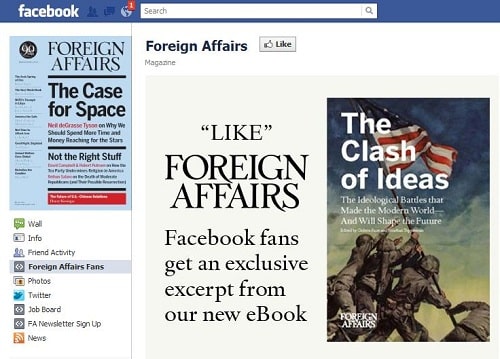Quick Overview

Through data-driven marketing, Foreign Affairs is selling millions of dollars of subscriptions a year, the vast majority of which contain online content. Deputy Publisher & Director of Digital Strategy Lynda Hammes gave us an exclusive peek as to how a print journal founded in 1922 has successfully marketed online subscriptions. Includes useful tips on getting Facebook likes, optimizing PPC landing pages, and converting more free traffic into paying subscribers.
Company Snapshot
Founded: 1922 in print, 1998 online (paywall implemented in 2004)
No. of Publications: 1
Employees: 25 full-time
Business Model: Hybrid. Paid content 75%, Advertising 25%
Paying Subscribers: 170,000 (50% Plus, 23% Digital, 17% Print, 8% eReader)
Location: New York, NY
Website: www.foreignaffairs.com
www.cfr.org (parent organization)
Target Market
Foreign Affairs appeals to both professionals in the foreign policy arena (i.e., diplomats, policy makers, journalists, economists, professors) as well as individual consumers who may have studied international relations, economics, or foreign policy in college and continue to be interested in the topics Foreign Affairs covers (note: the latter market expanded after 9/11). Hammes suspects it’s about a 50/50 breakdown between the two, with the majority of subscribers in the U.S. The publication’s policy is to “maximize both the readership and the revenue from both audiences,” though they “believe that the biggest growth potential is among general readers.”
Content

Foreign Affairs has written content and produced videos covering world economics, the environment, security, law & institutions, politics & society, and U.S. policy, written by celebrity thought leaders, such as Richard Holbrooke, Neil deGrasse Tyson, and Henry Kissinger.
The foundation of the content was the printed bi-monthly magazine (i.e., six times a year), which continues to this day. But the site also contains a wealth of both free and paid content. Some content is completely free (example), while some requires email registration to keep viewing (example); the decision whether to make content free or require registration is left to the discretion of the editors. The free and registration-required content includes brief articles, letters from thought-leaders, reading lists, updates on ongoing stories, letter to the editors, reviews, and news.
The premium content (some of which is free for a limited time before it moves behind a paywall) contains commentaries, essays and responses from thought-leaders, as well as first chapters of books, abridged eBooks, topical and timely videos, curated articles from the archives, blog posts from editors, interviews with authors, and event tickets. Most of the paywalled content is marked with an icon (see image), and offers a 250-word preview.
Revenues Streams
Every year Foreign Affairs grosses millions of dollars, 75% of which is from multiple forms of paid content, 25% of which is from advertising, the majority of which is print.
Subscriptions: 45% of revenues are from print, digital and plus subscriptions. Foreign Affairs multiple subscription options include
- Digital with prices ranging from $19.95 per year for U.S. students to $69.95 per year for subscribers outside of the U.S. and Canada. Digital has full access to the basic website.
- Print + Online with prices ranging from $24.95 for U.S. students to $75.95 for international subscribers. This option includes 6 print issues, plus what the digital subscribers get, with the sole exception of PDF replica editions of the print magazine. However, all of the content within those replicas are online.
- Plus with prices ranging from $25.95 for U.S. students to $75.95 for subscribers outside the U.S. and Canada. Plus subscribers get all content, both print and online, plus bonus content including first chapters of books, abridged eBooks, topical and timely videos, curated articles from the archives, blog posts from editors, interviews with authors, and event tickets.
Foreign Affairs does not accept international currencies, which Hammes says hasn’t been a problem because most subscribers are using credit cards that convert from local currency to U.S. dollars according to that day’s currency conversion rate.
Hammes says Foreign Affairs is constantly price testing and the publication has had some success with low introductory offers, such as a special during their 90th anniversary in January, which resulted in 57% more subscriptions that month. However, they are very cautious in employing this technique because they don’t want to devalue digital content by dropping the price too low.
In the U.S., the plus option is the most popular, especially among new subscribers. Print follows, then digital. In Canada, plus is again the most popular, but followed by digital, then print. For subscribers in other countries, digital and plus are the most popular options, followed by print. Understandably, mailing time and costs make print the least popular option outside of the U.S. Also interestingly, in the U.S., the basic digital plan is the least popular option. There are also differences in plan popularity based on whether the subscriber is new, renewing or student (see chart below).

Additional Paid Content Sales: 30% of Foreign Affairs total revenue comes from the sale of additional paid content, such as:
- eReader: Foreign Affairs has 15,000 eReader subscribers on Nook, Kindle, Sony Reader and Zinio. The price for an eReader subscription varies from $1.99 / month (Kindle and Sony Reader) to $2.99 per month (Nook), to $34.95/year (Zinio).
- One-Offs: The publication also sells single-issues of the print journal on newsstands ($9.98), single-issue digital editions online ($7.95), and single article PDFs ($2.95).
- Textbooks: Foreign Affairs also works with third-party vendors to create customized textbooks on certain foreign policy topics (they license the content and the third-party vendors sell it).
- Event tickets: Foreign Affairs lets non-subscribers purchase tickets to their in-house bi-monthly events at the Council on Foreign Relations, which feature talks and Q&As with their writers and editors.
Marketing Tactics
Foreign Affairs employs a variety of marketing tactics and best practices, using both online and offline methods to drive traffic to their site and increase their readership and revenues.
Online Subscription Marketing
In addition to the 34% of direct site traffic, Foreign Affairs readers come to the site through the following methods:
- Search Marketing: 44% of total site traffic comes from search. The site itself is only moderately optimized, but high brand recognition and more than 1,000 inbound links from high-value sites help a great deal.
- PPC: Their PPC campaigns are focused completely on subscription offers. In addition, while a search for their title brings up both organic and PPC results, the landing page for the PPC ad takes you directly to a subscription offer instead of the homepage.
- Inbound Links: Foreign Affairs has maximized their inbound links, which drives 17% of traffic. This is mostly accomplished by creating multiple RSS feeds — one global feed, one by article type, and one by region — and encouraging site visitors to use their RSS feed on their site or blog. This is a great way to build links with bloggers, increase SEO and track who the most influential bloggers are in your niche, who you can later approach with special campaigns (see our recent tip on this practice.)
- Social Media: On average, 5% of site traffic is driven by social, however, in December of 2011, that number jumped to 11%. The publication’s Facebook page has more than 58,800 likes and offers a book in PDF form when visitors like their page (see image). On twitter, Foreign Affairs has 67,254 followers, while following only 653 others, a definite best practice in establishing one’s publication and brand as an authority. They also have a personalized YouTube channel with a banner and button to subscribe, another best practice.

Once the traffic gets to the site, it’s converted through free email registration and hard offers:
- Free email registration: Visitors can sign up for a free weekly newsletter of free content, which goes out on Thursday, and has shown a consistent spike in traffic on Fridays (note: if you have a lot of free opt-ins and employ a weekly email campaign, make sure your site can handle an influx of traffic).
Registered visitors are also sent a monthly promotional email with a sampling of what’s in the current issue of Foreign Affairs. These emails have an open/click-through rate of 20-22%, and about 2,368 of new subscribers were acquired through this method in 2011. FA segments its email list by location (U.S. v. Canada v. International), by regular v. former readers, and by subscribers v. non-subscribers. They also integrate email signups into all article pages. Hammes says the company’s policy is to “market to people who have spent time on the website by reading content.”
- Hard Offers: Foreign Affairs also measures which global links on their site get the most orders. They’ve found that their top navigation bar leads to 13% of orders, their cover ad 9%, their premium content roadblock to 3% of orders, and their registration roadblock to only 1%. This is an interesting lesson, implying that their readers might be more likely to browse the publication and then return to the homepage to subscribe, rather than at the paywall.
Offline Marketing
Foreign Affairs understands the importance of brand recognition and offline marketing in increasing site traffic and subscription revenue. Their offline marketing efforts include:
- PR: Foreign Affairs will routinely pitch their editors and though leaders as guests on relevant television programs, such as Charlie Rose and Fareed Zakaria.
- Events: For in-house events (discussed in the Content section above), Foreign Affairs will often record talks and post them on the publication’s YouTube Channel. For the professional audience, Foreign Affairs will have a booth in an exhibition hall about once a year for academic conferences. They’re also a media sponsor for Davos and other economic forums around the world, where they will ship copies of their magazine to distribute for free and have authors speak on panels.
- Direct Mail: Despite their success in digital and online content, Foreign Affairs still relies on postal direct mail, conducting 3 major campaigns a year, each with 600,000+ mailings. They target prospects and expired accounts through these mailings. Hammes said that the mailings are not really profitable in the first year or two, but because they have strong renewal and retention rates, the mailings have a good return on investment.
- Word-of-mouth: Foreign Affairs has no formal word of mouth program, but an informal survey found that 39% of readers were exposed to the publication in an education setting, such as a college course.
Retention
Hammes says that the publication’s primary retention tactic is to “focus on editorial excellence,” a strategy that is then reinforced by selling subscriptions on an auto-renew basis (see our On-Demand Video with Lisa Dubrow to learn how to employ this tactic). Currently, all subscriptions and all renewals are sold on an auto-renewal basis, and the marketing team is working on moving over older accounts that are not yet on an auto-renew basis. The average account lifetime is 3.5 — 4 years.
Cross-Sales and Upsales
In addition to trying to upsell print and digital subscribers into their plus subscription plan, Foreign Affairs also cross-sells event tickets, ebook collections and printed books through their site, some of which are published through third parties. These are sold via email marketing to house lists, some SEM, and display ads on their website and in their magazine. Hammes says they put effort into cross-sales and upsales, but not as much as they put into converting people to subscribers.
About Lynda Hammes
Lynda Hammes got her start as a marketer in the book department of Foreign Affairs, back when they were producing books in-house. She then transitioned to circulation, and her experience and success at Foreign Affairs has allowed her to transition to academia herself, as a business class instructor at Bard College.
Hammes’s best advice is to “never underestimate the value of quality content.” She feels the strength of Foreign Affairs is its ability to give prospects a taste of its content, which has a unique value, therefore making people willing to pay for it.
Vendors & Technology
Foreign Affairs handles its email management, web development, video production, and editing in house. Some of its third-party vendors include:
CMS – Drupal
http://drupal.org/
Website Hosting — Amazon
http://aws.amazon.com/web-hosting/
Ecommerce hosting and subscription fulfillment — Time Customer Service
http://www.timecustomerservice.com/
Payment processing — PaymentTech through TCS
http://www.chasepaymentech.com/
Web design — Concentric Studio
http://concentric-studio.com/
Circulation Consultancy — ProCirc (*Highly endorsed by Hammes)
http://www.procirc.com/procirc.shtml
Site Metrics — Omniture Site Catalyst
http://www.omniture.com/en/products/analytics/sitecatalyst
Insider Analysis
Overall, Foreign Affairs has transitioned a legacy print publication to the digital space with outstanding success, given that only 17% have chosen print and the most basic level of online access, with the majority choosing online-only or enhanced digital access. They’ve also creating a data-driven revenue model that attracts both consumer and professional audiences and is likely to grow in its reliance on digital content — ensuring the publication’s continued success — despite a late arrival to the online paid content party.
We are inspired by the following top 10 lessons they have to offer other digital publishers:
- Require an email registration for FREE content;
- Track where your visitors convert. You may find homepage ads to be more effective than paywall registrations;
- Take advantage of company milestones (90th anniversary) to offer your readers a special offer (also subtly reinforces how important/successful you are);
- The popularity of subscription offers may vary by geographic location, especially when targeting audiences outside the U.S.;
- You can cross-sell and upsell archived content by repackaging it with a new intro and timing its promotion to current events or industry trends;
- PPC ads for your brand name should link to a subscription offer, not your homepage;
- Offer a sample of premium content in exchange for a “like” on social media;
- Brand social media when you can, such as a banner with a subscribe button on YouTube;
- Use your RSS feeds to reach out, track and then leverage your relationship with influential bloggers; and
- Direct postal mail, while more expensive, can be a critical marketing technique, especially when mailing lists are segmented by user and type.
Our recommendations for how Foreign Affairs can grow further include optimizing their conversions on the paywall pages with some A/B testing and creating separate landing pages for U.S., Canada, and International subscription offers (starting with the pages linked to their PPC campaigns). They may also want to start offering and accepting subscriptions in other currencies so that subscribers aren’t susceptible to fluctuating dollar-conversion rates. We wonder if it might be worth testing a 5-year subscription offer, or upselling current subscribers to a multi-year plan. But most of all, we’d love for them to search engine-optimize their site, especially since they cover current events and are likely losing a lot of traffic from trending stories. Their current search traffic is more due to the strength of their brand name and backlinks than onsite optimization, such as headline wording, page title tags, and navigation links, which are currently dictated by the print magazine’s legacy and not Web-savvy practices.







